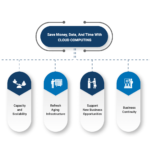How Telecommunications Empower Remote Work and Collaboration
- By -Mash
- Posted on
- Posted in Telecommunications
Telecommunications technology has fundamentally transformed the way we work and collaborate, making remote work not only feasible but increasingly effective. As organizations adapt to flexible work arrangements, telecommunications tools play a critical role in enabling seamless communication, collaboration, and productivity. This article explores how telecommunications empower remote work and collaboration and the benefits they offer to modern businesses.

Enhanced Communication Capabilities
Video Conferencing: Video conferencing tools, such as Zoom, Microsoft Teams, and Google Meet, facilitate face-to-face communication without the need for physical presence. These platforms support virtual meetings, webinars, and team discussions, allowing remote workers to interact as if they were in the same room. High-definition video and audio quality enhance the clarity of conversations and reduce misunderstandings.
Instant Messaging and Collaboration Platforms: Instant messaging applications like Slack and Microsoft Teams provide real-time communication, enabling teams to share information, ask questions, and collaborate quickly. These platforms support group chats, direct messaging, and file sharing, streamlining communication and keeping everyone on the same page.
Unified Communication Systems: Unified Communication (UC) systems integrate various communication channels—such as voice, video, messaging, and email—into a single platform. This integration simplifies communication processes, making it easier for remote workers to manage and access different modes of interaction from one interface.
Seamless Collaboration Tools
Document Sharing and Co-Authoring: Cloud-based platforms like Google Drive, Dropbox, and Microsoft OneDrive allow remote teams to store, share, and collaborate on documents in real-time. Multiple users can edit and comment on documents simultaneously, facilitating efficient teamwork and ensuring that everyone has access to the latest versions.
Project Management Software: Tools such as Asana, Trello, and Monday.com help teams manage projects, track progress, and assign tasks. These platforms provide visibility into project timelines, deadlines, and responsibilities, ensuring that remote team members stay organized and aligned on goals.
Virtual Whiteboards and Brainstorming Tools: Virtual whiteboards, like Miro and MURAL, enable remote teams to brainstorm, visualize ideas, and collaborate on creative projects. These tools offer interactive canvases where team members can add notes, diagrams, and other visual elements, mimicking the experience of a physical brainstorming session.
Improved Accessibility and Flexibility
Access from Any Location: Telecommunications technology supports remote work by allowing employees to access their work tools and resources from any location with an internet connection. This flexibility enables workers to contribute effectively from home, co-working spaces, or while traveling.
Mobile Connectivity: Mobile applications and solutions ensure that remote workers can stay connected and productive on the go. Smartphones and tablets equipped with communication and collaboration apps enable employees to manage tasks, attend meetings, and communicate with colleagues from anywhere.
Cloud Computing: Cloud-based services provide remote workers with access to applications, data, and collaboration tools without the need for on-premises infrastructure. Cloud computing supports flexible work arrangements and ensures that employees can work seamlessly from any device.
Enhancing Productivity and Efficiency
Real-Time Collaboration: Telecommunications tools enable real-time collaboration, reducing delays and improving the speed of decision-making. Teams can work together on documents, discuss ideas, and resolve issues instantly, leading to more efficient workflows and faster project completion.
Integration with Business Applications: Many telecommunications solutions integrate with existing business applications, such as Customer Relationship Management (CRM) systems and Enterprise Resource Planning (ERP) software. This integration streamlines processes and ensures that remote workers have the tools they need to perform their tasks effectively.
Task and Workflow Automation: Automation features in collaboration tools help streamline repetitive tasks and workflows. Automated notifications, reminders, and task assignments reduce the administrative burden on remote workers and help them focus on more strategic activities.
Strengthening Team Cohesion and Culture
Virtual Team Building: Telecommunications tools facilitate virtual team-building activities, such as online games, social events, and collaborative projects. These activities help build team cohesion and maintain a sense of connection among remote team members.
Regular Communication and Check-Ins: Regular virtual meetings and check-ins foster communication and engagement. Managers and team leaders can use video conferencing and messaging tools to provide updates, gather feedback, and ensure that remote workers feel supported and included.
Inclusive Work Environment: Telecommunications technology supports diverse and inclusive work environments by accommodating various work styles and needs. Remote work solutions enable organizations to tap into a global talent pool and provide opportunities for employees with different circumstances or preferences.
Overcoming Challenges and Considerations
Cybersecurity and Data Protection: Ensuring the security of remote work environments is crucial. Telecommunications systems must include robust cybersecurity measures, such as encryption and multi-factor authentication, to protect sensitive data and maintain privacy.
Technology Access and Reliability: Providing remote workers with reliable internet access and compatible devices is essential for effective collaboration. Organizations should address technology barriers and offer support to ensure that all employees can fully participate in remote work.
Maintaining Work-Life Balance: Telecommunications tools can blur the lines between work and personal life. It’s important for organizations to promote healthy work-life balance practices and encourage employees to set boundaries and manage their time effectively.
Conclusion
Telecommunications technology plays a pivotal role in empowering remote work and collaboration by enhancing communication, providing seamless access to tools, and supporting flexible work arrangements. The integration of video conferencing, instant messaging, cloud computing, and collaboration platforms enables teams to work efficiently and effectively from any location. As organizations continue to embrace remote work, leveraging telecommunications technology will be key to maintaining productivity, fostering team cohesion, and overcoming the challenges of a distributed workforce.



